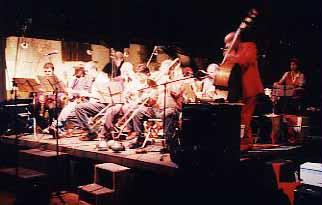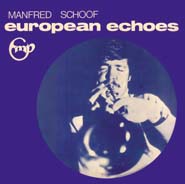FREE JAZZ ORCHESTRAS

Little Huey Orchestra, photo courtesy of Aum Fidelity
NOT OXYMORONIC AT ALL. REALLY.
By Phil Freeman (January 2003)
These ensembles, among others, have been responsible
for some of the most fascinating free jazz recordings of all, precisely
because of the seeming contradiction at the heart of the process. How does
one gather eighteen or more musicians, each one committed to free improvisation,
and put them in harness for a half-hour (or longer) of collective effort,
without losing the very freedom that makes their music, as individuals,
compelling in the first place? It's a delicate balance, and when it fails,
the results can be much uglier than when a soloist in a duo, trio or quartet
loses his or her train of thought on the bandstand. But when it works,
the effect is something close to magical. The three albums I've chosen
to discuss in this article are among the most unique and powerful in all
of free jazz, because they succeed in bridging the gap between unfettered
improvisation and the sweeping power of an orchestra in full flight.

Courtesy of ECM
Records
The Jazz Composer's Orchestra was created and conducted by Michael Mantler in the late 1960's. Most of their self-released albums, on Mantler's JCOA label, are out of print. Their debut release, Communications, remains available though, distributed by ECM, and it's one of the most out records of the 1960's, a sound object that will open the listener's skull to the sky like little else. The Orchestra itself numbered 21 players, including seven saxophonists and five bassists playing simultaneously. The musicians were among the top players available, then or now: Steve Lacy, Randy Brecker, Jimmy Knepper, Carla Bley, Charlie Haden, Ron Carter, Reggie Workman, Andrew Cyrille, Beaver Harris, Alan Silva, Jimmy Lyons, Gato Barbieri and many others. The album Communications was recorded throughout 1968, at four sessions (January 24, May 8, and June 20 and 21). Each track on the original double album featured a soloist or two fronting the Orchestra. On "Communications #8," it was Don Cherry on trumpet and Gato Barbieri on tenor sax, creating a zone of relative safety to ease the listener in. On "Communications #9," Larry Coryell's guitar was featured, at the beginning and end of the piece. The combination of sounds there was bracing in the extreme, as Coryell abandoned jazz chording and went into an amp-frying zone of pure skronk the likes of which would have sent even Hendrix and Sharrock scurrying for the exits. The third cut, "Communications #10," showcases Roswell Rudd's trombone to great effect. After that lengthy workout, "Preview" is like a blast of cold water in the face - three minutes of Mingus-like vamping from the ensemble, and over the top of it, Pharoah Sanders screaming through his horn like someone's set his hair on fire. The final piece on the disc, though, is the real treasure.
"Communications #11," divided into two parts and making up the entire second disc of the original vinyl, finds the orchestra fronted (and commanded, frankly; Mantler, the putative head, could just as well have gone home) by piano titan Cecil Taylor. Taylor is on it from the first note, assaulting the keyboard in a thoroughly unseemly, yet raucously beautiful manner and somehow managing to get 21 musicians following his every move, rather than making any attempt to find a point of entry into whatever they might have considered doing themselves. This 35-minute release could easily have been released separately, under Cecil's own banner. Listening to it is a frankly overwhelming experience, and provides the perfect conclusion to a record that really should be in every serious out-jazz fan's collection.

Photo courtesy of Atavistic
On the other side of the Atlantic, in 1969, trumpeter Manfred Schoof assembled his own 16-piece band for the recording of European Echoes, one of the first albums released on the now-legendary FMP label. This group was an all-star collection of the biggest names in European improvisation at the time, including trumpeters Enrico Rava, Schoof, and Hugh Steinmetz; saxophonists Peter Brötzmann, Gerd Dudek and Evan Parker; trombonist Paul Rutherford; guitarist Derek Bailey; three pianists (Fred Van Hove, Alexander Von Schlippenbach and Irene Schweitzer); bassists Arjen Gorter, Peter Kowald, and Buschi Neibergall; and drummers Han Bennink and Pierre Favre. This seemingly unwieldy (three pianos?) bunch of decidedly free spirits lumbers and roars through the half-hour title piece, which is split between the album's two sides. The first half is all about the front line: it opens with a skin-tearing guitar solo from Bailey, who was quite the noisician in those days. After that, Parker, Rutherford, Brötzmann and Rava each take their turn in the spotlight, making as much noise as possible in order to be heard over the din. Then it's the pianists who take over; Von Schlippenbach, Van Hove and Schweizer, each attacking the keyboard like it's done something to them personally.
The second half of the disc is all about the rhythm section, at least at the start. It begins with a drum duo/duel between Bennink and Favre, which, as might be expected, is more than capable of moving small objects off the listener's bookshelves. After those two have wound themselves down, the three bassists get to rockin'. Peter Kowald is in particularly assaultive form, slamming the strings like he's trying to tear them off the neck entirely (he also does a fair amount of this on Peter Brötzmann's For Adolphe Sax, from 1967; look out for that one, too). The horns come back in at this point, saxophonist Dudek and trumpeter Steinmetz each taking a solo before Schoof himself steps to the microphone to wrap the proceedings up. This is one of the most forceful albums in European improv, up there with Brötzmann's Machine Gun for pure, face-kicking joy. And along with a bunch of other lost classics of the era, it's recently been reissued by Chicago's Atavistic label, as part of their Unheard Music series. They're to be commended for their efforts in bringing this stuff to a new audience.
Another legendary record that's just now finding fresh ears to maul and destroy is Alan Silva's Seasons, recorded in 1970 with the Celestrial Communications Orchestra. Like the Globe Unity Orchestra, the CCO was pretty much whoever Silva could round up for a given date, but this one-shot radio concert was its largest lineup ever. This mammoth slab of sound was originally released on the extraordinary BYG/Actuel label, on triple vinyl (just like Yessongs!). This year, it's been reissued in a limited edition by the Italian label Sunspots as a two-CD set. There are no "side" breaks on the discs though. What you get are two 70-minute sections of the piece, as close as anybody without a time machine's ever gonna get to hearing it as it was in December '70, when this thing erupted through the earth and stood, shuddering and alive, before an audience of awestruck French hipsters. This is a serious piece of music. The band includes every member of the Art Ensemble of Chicago except bassist Malachi Favors; trumpeter Alan Shorter; saxophonist Steve Lacy; two electric violinists; two cellists; pianists Dave Burrell and Joachim Kühn; Silva himself on bass, electric violin, and a couple of different electroacoustic instruments; and nearly a dozen other folks, all roaring in unison for two solid hours and then some. The music combines the eerie tones of 20th Century avant-garde composers like Xenakis or Christian Wolff with the blood-bubbling scream of primo free jazz. For about the first five minutes or so, all seems well, the piece shimmering out of the speakers as a duo for bowed bass and piano. But by fifteen minutes in, after Lester Bowie's muted trumpet has summoned the whole blaring outfit to full awareness, it's just one surging wave of sound after another, as relentless as the tides and as powerful, sweeping everything before it. Saxophone solos, triple-piano crescendos; this disc's got everything, and throws it all at you, one thing after another until you're panting as hard as the two drummers must have been. It's literally breathtaking, and the fact that it's half an afternoon if you decide to sit down and listen to the whole damn thing only adds to the generally overwhelming vibe. Not for the faint of heart, but recommended to everyone else.
These days, the diminished audience for free jazz (like it was ever huge, even in the '60's) and the lack of available funds, from record companies or arts promoters, have combined to make large-ensemble works, and large ensembles, a comparative rarity. Cecil Taylor mustered one up at the Knitting Factory in 2002, and nobody could believe it. About the only genuine free jazz orchestra of any stature beyond a one-shot, these days, is bassist William Parker's Little Huey Creative Music Orchestra. They've released two double-discs on the Aum Fidelity label, Sunrise In The Tone World and Mayor of Punkville, and two single albums, Flowers Grow In My Room on Parker's own Centering label, and Raincoat In the River on the fine Massachusetts indie label Eremite. Parker assembles a version of the Orchestra each year at the Vision Festival in New York, and sometimes a club gig will come along; they once did a months-long weekend residency at Tonic, on New York's Lower East Side. Of their recorded output, Mayor of Punkville and Raincoat In the River are the definite highlights. The former's half-hour track, "I Can't Believe I Am Here," is like a whale breaking the ocean's surface so it can stick its tongue out at you-a perfect contrast to the gentle ballad "James Baldwin To the Rescue," sung by Aleta Hayes over a serene and pastoral vamp like icebergs doing Busby Berkeley choreography. Raincoat In the River finds the Orchestra incorporating non-"jazz" sounds into their palette; Parker plays bombard, shakuhachi and marimba in addition to bass, and the whole concert documented on the disc is far more meditative and welcoming than any of the 1960's works described above. Part of this is, of course, a testament to the huge spirit of William Parker; the guy's basically a hug walking on two legs.
But it also indicates something about why a person would choose to create free jazz works on a massive scale, like the ones described above. When the Little Huey Creative Music Orchestra gathers in a space, it's not so much to see whether they can bring the walls down as to see whether they can harness all their spirits and lift the audience up and out, to dance amid the stars for awhile. It's like one of Richard Serra's gigantic steel spirals. From the outside, it's huge, heavy and imposing. Then you slowly walk into it, following its curves, and by the time you reach the inner chamber, light filtering down from above and making the rusted metal sides almost glow, you feel totally enfolded, and this thing, which once felt like it would surely crush you beneath it, now feels like the most intimate space you've ever entered, and you're hard-pressed not to go get a sleeping bag and just curl up inside. Like that.